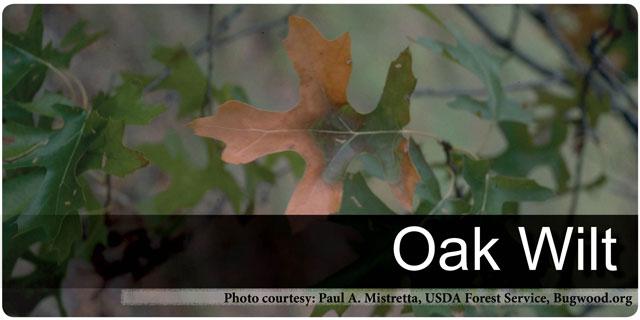Oak Wilt
Oak Wilt is a fungal disease that is killing oak trees throughout the mid-west and into pockets of Texas and the southeast. The fungus grows in the vascular system of trees, cutting off the supply of water and nutrients, causing leaf discoloration, wilt, leaf drop and eventually death. So far all oaks are thought to be susceptible to Oak Wilt, however disease is typically most severe on red oak species.
What is it?
The Oak Wilt fungus (Ceratocystis fagacearum) grows in the vascular tissue of infected trees and, once established, spores of the fungus can spread systemically throughout to tree. Although the origin of the pathogen that causes Oak Wilt is unknown, it is thought to be invasive, first detected in Wisconsin in 1944.
Various bark beetles may carry Oak Wilt spores from infected trees to healthy trees as they feed and lay eggs. In addition, as the root systems of oaks trees frequently merge through natural root grafts, fungal spores traveling in the vascular system of infected trees can be transmitted to nearby connected healthy trees.
What does it do?
The Oak Wilt pathogen grows in the outer sapwood of trees. As it grows, oaks react by producing tyloses that cut off the flow of water and nutrients. This can effectively girdles the affected trunk or branches and can kill the tree.
Oak Wilt symptoms are different on red and white oak species. In red oaks, disease tends to be more severe and progresses more rapidly. Symptoms may start within a few weeks and tree death can occur within several months. Initial symptoms on red oak include wilting and bronzing of leaves, starting at the tops and tips of branches and then continuing to the rest of the tree. This is followed by a gradual leaf drop of leaves of all stages of discoloration. As the fungus grows it produces a gray/tan mycelial mat under the bark of dead and dying trees which has a distinctive fermenting smell and may raise and split the bark.
White oaks species, on the other hand, are more resistant and may live for several years after infection. The symptoms are similar to those of red oak but less pronounced (leaf discoloration may resemble annual fall color changes and take much longer, with death typically occurring one branch at a time) and mycelial mats under bark are typically absent.

